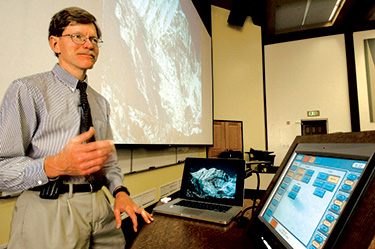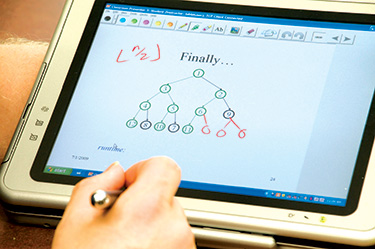Christy Luther, ‘01, walks some of the same University of Washington paths as her dad, Kirby Luther, ‘71, ‘73, and her grandmother, Betty Fox Luther, ‘41. Every spring, she delights in the cherry blossoms on the Quad and she has taken classes in buildings like Denny Hall, just as they did.
But that’s where the similarities end. Her school tools are way more sophisticated. Instead of manual typewriters and card catalogs, she uses e-mail, Twitter, podcasts, blogs, a laptop computer and a cell phone with Internet access.
“Things have changed a lot,” she says. “Even since I got my undergraduate degree from UW in 2001.”
Today, Luther, 29, is at the UW studying for a master’s degree in digital media communication—a field of study that didn’t even exist a few years ago. Some of her classrooms are equipped with banks of desktop computers, but even that is blasé nowadays, since most students bring laptops. The classroom experience at the UW is being transformed because of new, sophisticated technology.
Universities are upgrading classroom technology because teaching has gone far beyond hardbound textbooks, and professors want multiple tools in the classroom. Indeed, new classroom technology sometimes begins with university researchers.
“Technology is allowing faculty to be more innovative, more spur-of-the-moment in instruction,” says Patrick Roberts, associate director of UW Classroom Support Services.
Also, many students and parents expect technological sophistication; in many cases, it has already been part of their educational experience.

Medical School professor Scott Weigle in action with a computerized podium and Medin screen.
Compared to that of peer institutions, UW’s classroom technology is “better than average, with some outstanding efforts, but at not a consistently high level,” says Mike Eisenberg, a professor and dean emeritus at the UW Information School. “The University hasn’t put a lot of money into learning technologies. There’s no straight-line item in the budget.”
With University budgets tight as a CD in a plastic case, outside prospects for additional funding have become increasingly important. Currently, 36 of the 300 classrooms on the UW Seattle campus, including 14 in Mary Gates Hall, have been upgraded. The Mary Gates upgrades completed this past summer cost about $600,000 and are part of a $3 million gift from the Gates family that provided a first round of technological upgrades as part of a building renovation 10 years ago.
Working from podiums in the 14 Mary Gates classrooms, professors can control a projector, a desktop computer or a personal laptop, a DVD player, a VCR, a Blu-Ray player, one or two projection screens and several banks of room lights. There are also remote microphones, which allow movement away from the podium.
These classrooms are also fitted for “course casting,” a juiced-up version of podcasting. A camera and a microphone capture the professor’s lecture and any PowerPoint material. They are then brought together at a course Web site, so that if a student misses a class or wishes to review course material, it’s available any time.
Some Mary Gates classrooms include document cameras, which allow a person to write on a sheet of paper and then project the work onto a screen. Five classrooms are equipped for videoconferencing, which not only extends learning possibilities but makes travel unnecessary, thus saving time and energy.
[Hanson] Hosein and his students check responses in real-time or later on, getting a pulse on class thoughts as well as a permanent record of what was said.
Classroom Support Services designed the new systems to be user friendly; buttons on the touch-screen podiums offer clear options about such things as course casting and videoconferencing.
“Use a microphone, tell the students where to find the recordings and we do the rest,” says David Aldrich, assistant director of Classroom Support Services.
Technicians constantly monitor equipment, paying attention to things like projector bulbs, which cost about $500 apiece. If a professor forgets to turn off the projector at the end of class, Classroom Support Services does it remotely.
Technicians also bring equipment to old-style classrooms. This past spring, Visiting Lecturer Arista Cirtautas had videoconferencing equipment brought to her political science class in Thomson Hall so she could host guest lecturers from Baltimore, Boston and Christchurch, New Zealand.
Most of the time, UW Medicine Professor Scott Weigle teaches his human physiology class with transparencies and an overhead projector. While relatively low tech, the transparencies keep Weigle from getting too far ahead of students, who are taking notes as he talks. But sometimes Weigle plugs his MacBook Pro into a touch-screen podium, pops in a DVD and shows DNA replicating—to music. Or, as an introduction to high-altitude physiology, he shows a few slides of his trekking in Nepal this past spring.

A student uses a touchpad in class.
Richard Anderson, a UW professor of computer science, likes the same kind of flexible instruction. He developed Classroom Presenter software for Windows laptops, so users can build course lectures with PowerPoint and then elaborate by writing directly onto the computer screen.
As part of experimenting with Classroom Presenter, Anderson and his colleagues have distributed tablet laptops in various classes, asking students to brainstorm questions and then e-mail answers to the instructor, who pops anonymous answers onto a large screen for discussion.
Hanson Hosein (pictured at top), who directs the Master of Communication in Digital Media Program at the UW, uses Twitter, the tool for 140-character microblogging, to encourage discussion in his classes. He sometimes suggests that students tweet responses to his ideas or those of others, marking them with a hash tag—the pound symbol and a keyword such as #mcdm581. Hosein and his students check responses in real-time or later on, getting a pulse on class thoughts as well as a permanent record of what was said.
Hosein noticed, for example, a Twitter conversation about whether one of the authors read in the course advocates socialism. It led him to kick off a class with “The New Socialism,” which had just been published in Wired magazine.
Twitter encourages more participation, especially among shy students, Hosein said. Twittering or text messaging during class can distract from work at hand, he acknowledged, but such tools can also prevent irrelevant activities such as Web surfing.
At the Information School, Eisenberg thinks much of the future lies in blending regular, in-person classes with online communication, so members of a class can talk and work together every day.
Key parts of UW classes continue gravitating to the Web. For example, more than 80 percent of UW faculty members have Web sites for their courses, Eisenberg says. “Students expect Web sites instead of or in addition to printed syllabi,” he adds.
Eisenberg’s courses include Intellectual Foundations of Informatics, an undergraduate class that considers information as an object of study and explores ways to build information systems.
Since there is no best textbook for the course, and because textbooks are so expensive, Eisenberg uses UW Electronic Reserve to make articles and book chapters available to his students. He and many faculty members also use GoPost, a Catalyst tool developed by UW Learning & Scholarly Technologies, for online class discussions. For assignments, they use Collect It, another Catalyst tool, which allows students to electronically submit assignments and professors to retrieve, grade and return them.
The Information School offers an online master’s degree in library and information science, the only accredited such program in an eight-state region.
During winter quarter this past year, Catalyst launched GradeBook, which, according to Eisenberg, has received positive marks from many faculty members.
For a winter-quarter course, Eisenberg moved part of his material onto Facebook, saying “that’s where students are already.” They discuss what’s been said in class and bring up additional material. “A class that meets twice a week can be in touch all week long,” Eisenberg says. It means extra work for faculty members but deepens learning.
The Information School offers an online master’s degree in library and information science, the only accredited such program in an eight-state region. Students come to campus three times a year but otherwise do class work online. “This blending has really extended our ability to meet people’s needs and give quality education,” Eisenberg explains.
Althea Burton, a student in the Executive Master of Science in Information Management Program, which is geared for working professionals, likes the combination of in-person and online coursework. “Knowing I can revisit the lecture allows me more time to engage than be a scribbler or pretend that I am a court reporter trying to catch every single detail on my laptop,” she says.
While these online efforts have lowered campus costs, Eisenberg says they’ll never entirely replace humans’ need to be together physically.
“Look, people could stay home and work on their laptops,” he points out. “But what do they do? They go to coffeehouses.”
No books? They can Kindle it
 Today’s students like it simple. Their phones, Facebook apps and cameras all fit in their pockets, so it was just a matter of time before their study habits entered the digital age as well.
Today’s students like it simple. Their phones, Facebook apps and cameras all fit in their pockets, so it was just a matter of time before their study habits entered the digital age as well.
Starting this fall, approximately 150 University of Washington students will be given Amazon.com’s latest electronic reading device, the Kindle DX, as part of the Kindle pilot program. Sporting a 9.7-inch screen and weighing just 18.9 ounces, the Kindle DX can hold up to 3,500 books and is capable of storing entire textbooks as a digital file. The UW is one of seven institutions nationwide participating in the program.
“There are huge advantages to not carrying around 30 pounds of textbooks everywhere you go,” says Ed Lazowska, Bill & Melinda Gates Chair in Computer Science & Engineering, which has 60 graduate students in the pilot program. Master’s candidates in the Technology Management MBA program will participate, beginning in January.
If the Kindle DX—a personal reader by definition—can help students manage their schoolwork, the days of carrying heavy textbooks to and from class could soon be over.